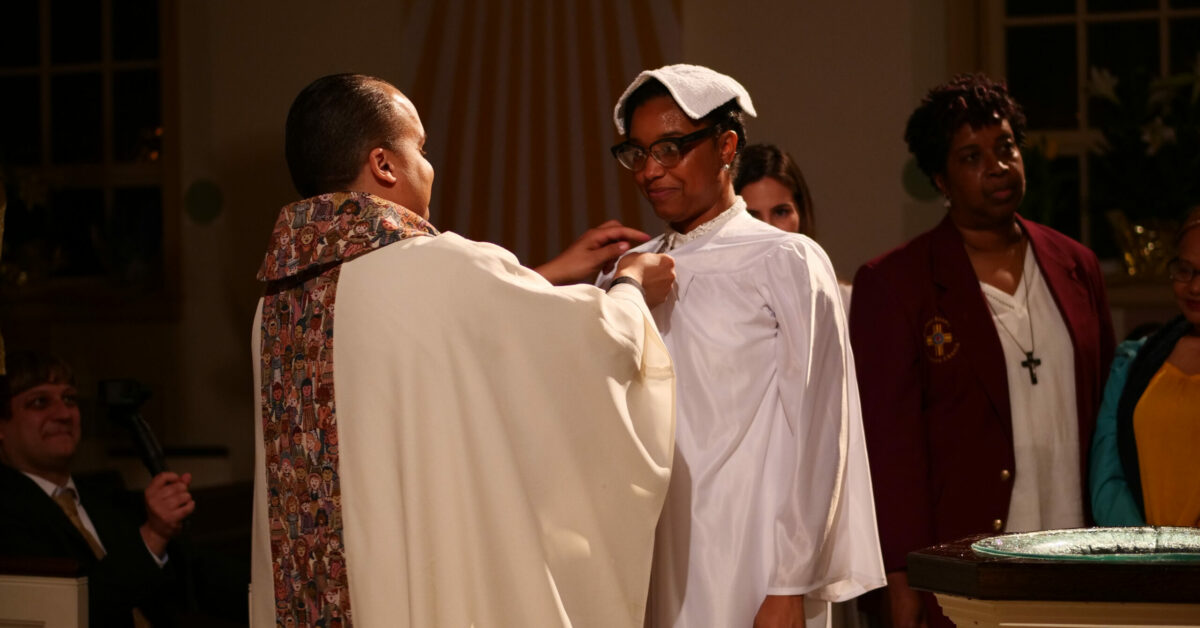Awe-Inspiring: Feet Washed and Clothed in White
In our last post on the 4th century mystagogical catecheses, Rhoda explored the enriching images grounded in Jesus’ own baptism: being anointed by the Spirit and chosen as God’s child. We were going to turn to the third part of the rites of initiation, the Eucharist, today. But I (Kent) can’t miss the opportunity to explore more of the multivalence of baptism. Two other post-baptismal rites depict the wonder of baptism into the name of the saving Triune God: the foot washing in the Ambrosian rite and the clothing in white. First, the unique foot washing.
The baptismal foot washing (distinct from the Maundy Thursday footwashing) was a peculiar custom of Milan (although Yarnold, p.30, does note that it was known elsewhere in the rites in Turin, Gaul, and parts of North Africa). Ambrose specifically states, “We are aware that the Roman Church does not follow this custom, although we take her as our prototype, and follow her rite in everything” (Yarnold, The Awe-Inspiring Rites of Initiation, 122). Ambrose is holding his ground for distinctly regional and cultural ritual practices. One would expect Ambrose to interpret the foot washing in a similar way to the Maundy Thursday foot washing as “an injunction upon the neophyte to perform humble service to others in the spirit of our Lord’s words” (31). He doesn’t dismiss that understanding. But Ambrose interprets its significance primarily as sacramental (the early church had a broad view of what was sacramental in nature—conveying the mystery of participation in Christ’s salvation). Arguing against those who say the foot washing “should not be performed as a mystery . . . not for regeneration” (122), Ambrose says
The Lord answered . . . “He who has washed, does not need to wash again, except his feet only.” Why? Because in baptism all guilt is washed away. The guilt has disappeared; but Adam was tripped and thrown by the devil, so that the devil’s poison infected his feet; so you have your feet washed, in order to receive the special help of sanctification in the place where the serpent lay in ambush so that he cannot trip you up again (123).
While we might not resonate with the literalism of the devil’s poison infecting our feet, the foot washing as an ongoing symbol of sanctification, of walking in the gifts of the Spirit, is potent. The journey begins at baptism and what better way to have your feet shod than to have them washed by the Lord himself.
It is important not only to have your feet prepared, but to be clothed properly. Since the neophytes were baptized naked, they had to be clothed. All the rites of the mytagogues indicate that “these robes were a symbol of the life of the resurrection to which the new Christians had now passed, and of the innocence that should now distinguish them” (31). Using the words of Isaiah (61:10), Cyril of Jerusalem says,
Once you have stripped off the old garments and put on those which are spiritually white, you must be clad in white always . . . your spiritual dress must be truly white and shining . . . in the words of the blessed Isaiah, “Let my soul rejoice in the Lord: he has clothed me with the garment of salvation, and with the robe of gladness he has covered me” (89).
The white robe is the garment of the resurrection, of the eschatological feast. Chrysostom, in a sermon preached in the context of the mystagogy, says,
Now the neophytes carry Christ himself, not on their clothes, but dwelling in their souls with his Father, and the Holy Spirit has descended on them there. They are even more obliged, then, to prove themselves reliable, and show everyone by their scrupulous conduct and careful lives that they wear the imperial badge [of the Lord of all creation] (32).
It is, in Theodore of Mopsuestia’s words, “a dazzling garment of pure white. This is a sign of the world of shining splendor and the way of life to which you have already passed in symbol” (197-8).
Through baptism, clothed in the radiance of the risen Lord. And shod for the journey to the kingdom with your feet cleanly washed. The baptized “shine as brightly as the rays of the sun” (163).
